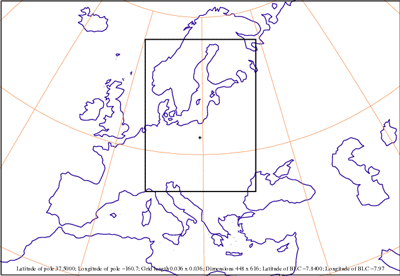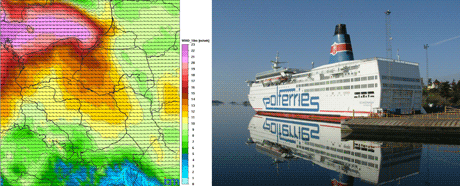The weather prediction projects conducted by ICM have quite a large impact on the meteorological community in Poland. ICM serves the public by forecasting the evolution of the state of the atmosphere over central Europe. The results of these computations are available to the general public in the form of detailed weather charts and diagrams presented on ICM's online weather pages. The operational results of the system are used by scientists developing other models, especially oceanographic ones in which forcing from atmospheric winds is treated as an initial condition.
The new generation of numerical weather forecasting models has arisen from continuous development and is the domain of professional meteorological agencies. In particular, the Unified Model (UM) comes from the British Meteorological Office, and COAMPS (Coupled Ocean/Atmosphere Mesoscale Prediction System) was developed by the US Naval Research Laboratory. These models are non-hydrostatic, meaning they use fully three-dimensional equations for atmospheric dynamics. UM and COAMPS also describe new scales of phenomena based on a very dense computational Grid.
Switching these models into operational service means running them permanently using the same daily procedure. This includes transmission of the input data, analysis of initial conditions, model runs and results processing. Operational runs need to produce up-to-date forecasts and so must be performed as fast as possible. The huge amount of data and computations motivates the use of supercomputers. 'Super' indicates computers that have a lot of memory and fast processor(s), allowing the forecast to be computed in a short time interval.
ICM operates a computational centre that is made freely available to the scientific community. As numerical weather forecasting has always been a challenging computational task, vector supercomputers were used. In fact, a long line of successive generations of Cray vector machines has seen service at the centre.

Numerical models of atmospheric dynamics are based on a number of differential equations. These are solved on a discrete grid of points that corresponds to a number of geographical positions and vertical levels. This forms a full three dimensional model. The new models are constructed on a spatial grid with 4km resolution or better. Each equation needs initial data and boundary conditions to be solved. These are carefully prepared with use of multi-source observational data.
Currently ICM runs three operational weather prediction models: UM v.4.5 (since 1997), COAMPS (since 2001) and UM v.6.1 (since 2008). In addition the sea-wave prediction model WAM for the Baltic Sea is computed with the use of COAMPS wind fields. Numerical weather prediction at ICM has always been strongly connected to its supercomputing capabilities. On the other hand, ICM staff have always been involved in the optimization of weather prediction computer codes on corresponding supercomputer architectures. The older version of UM was ported and optimized to work on Cray SV1ex. Both the COAMPS model and UM v. 6.1 were ported and optimized for Cray X1e.
Code Optimization
The ICM's brand new weather prediction system based on UM v.6.1 has two very important novel features. First of all in comparison to previous editions it has some milestone modelling changes, referred to by the Met Office as 'New Dynamics'. Secondly we decided to significantly decrease the grid size to approximately 4km while operating on the same geographic area. All of this made the initial installation of UM v.6.1 very time-consuming, and a single forecast run took more than five hours. Since we plan to perform four operational UM runs per day, we have started to look into opportunities for optimizing the code. The first class of optimizations was vectorization and loop unrolling, which was done with the use of specialized directions for the Cray Fortran compiler. Second, we found several opportunities to substitute some code fragments with machine intrinsics calls. The crucial considerations were those connected with the parallel configuration of the model. The computational domain was divided into a number of long rectangular stripes rather than into square elements. Due to better utilization of the vector processor unit, this resulted in improved performance and an overall speedup of almost three over the initial implementation.

Success Stories
ICM's numerical weather prediction systems have proven their usefulness both for operational and application purposes. Our weather pages are visited frequently by a variety of users, especially those interested in wind prediction, such as wind farm operators, motogliders, windsurfers and sailors. Recently we reported on a spectacular success achieved by Captain Wojciech Sobkowiak, in charge of the ferry MF Scandinavia operating on the Baltic Sea. Captain Sobkowiak used ICM's wind prediction charts to plan a cruise from Nynashamn to Gdansk on 25th of January this year. As he described it, "There was a storm behind us and no wind ahead".
Links:
ICM Numerical Weather Prediction: http://meteo.pl
ICM: http://www.icm.edu.pl
Met Office: http://www.metoffice.gov.uk
NRL: http://www.nrlmry.navy.mil
Please contact:
Maciej Szpindler, Maciej Cytowski
Interdisciplinary Centre for Mathematical and Computational Modelling (ICM),
University of Warsaw, Poland
E-mail: m.szpindler![]() icm.edu.pl, m.cytowski
icm.edu.pl, m.cytowski![]() icm.edu.pl
icm.edu.pl










